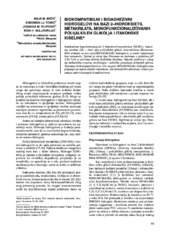Приказ основних података о документу
Biocompatible and bioadhesive hydrogels based on 2-hydroxyethyl methacrylate, monofunctional poly(alkylene glycol)s and itaconic acid
Biokompatibilni i bioadhezivni hidrogelovi na bazi 2-hidroksietil metakrilata, monofunkcionalizovanih poli(alkilen glikol)a i itakonske kiseline
| dc.creator | Mićić, Maja M. | |
| dc.creator | Tomić, Simonida | |
| dc.creator | Filipović, Jovanka M. | |
| dc.creator | Suljovrujić, Edin H. | |
| dc.date.accessioned | 2021-03-10T10:41:35Z | |
| dc.date.available | 2021-03-10T10:41:35Z | |
| dc.date.issued | 2007 | |
| dc.identifier.issn | 0367-598X | |
| dc.identifier.uri | http://TechnoRep.tmf.bg.ac.rs/handle/123456789/1063 | |
| dc.description.abstract | New types of hydrogels were prepared by the radical copolymerization of 2-hydroxyethyl methacrylate, itaconic acid and four different poly(alkylene glycol) (meth)acrylate components (Bisomers) in a water/ethanol mixture as solvent. The polymers swell in water at 25°C to yield homogeneous transparent hydrogels. All the hydrogels displayed pH sensitive behavior in buffers of the pH range from 2.20 to 7.40, under conditions similar to those of biological fluids. The presence of these two comonomers, which were added to HEMA, increased the swelling degree of the hydrogels and gave gels with better elasticity. The hydrogels were thermally stable in the vicinity of the physiological temperature (37°C). The copolymer containing pure poly(ethylene glycol) acrylate units generally had the best properties. The tests performed on the hydrogels confirmed that they were neither hemolytic nor cytotoxic. The copolymer samples showed better cell viability and less hemolytic activity than the PHEMA sample, confirming the assumption that poly(alkylene glycols) improve the biocompatibility of hydrogels. Due to their swelling and mechanical characteristics, as well as the very good biocompatibility and bioadhesive properties, poly(Bisomer/HEMA/IA) hydrogels are promising for utilization in the field of biomedicals, especially for the controlled release of drugs. | en |
| dc.description.abstract | Radikalnom kopolimerizacijom 2-hidroksietil metakrilata (HEMA), itakonske kiseline (IK) i četiri tipa poli(alkilen glikol) (met)akrilata (Bisomera-BIS) dobijeni su novi poli(BIS/HEMA/IK) hidrogelovi, u smeši voda/etanol kao rastvaraču. Ispitan je uticaj tipa Bisomera na bubrenje u puferima pH 2,20-7,40, u uslovima sličnim biološkim fluidima. Takođe, praćenje i uticaj na mehanička svojstva, morfologiju i termičko ponašanje dobijenih gelova. Testiranje biokompatibilnosti in vitro napoli (BIS/HEMA/IK) hidrogelovima pokazuje da nema ćelijske toksičnosti, niti hemolitičke aktivnosti. Gelovi poseduju zadovoljavajuću bioadhezivnost. | sr |
| dc.publisher | Association of Chemical Engineers of Serbia | |
| dc.rights | openAccess | |
| dc.rights.uri | https://creativecommons.org/licenses/by-nc-nd/4.0/ | |
| dc.source | Hemijska industrija | |
| dc.subject | 2-hydroxyethyl methacrylate | en |
| dc.subject | itaconic acid | en |
| dc.subject | poly(alkylene glycol) (meth)acrylates | en |
| dc.subject | hydrogels | en |
| dc.subject | hemolytic activity | en |
| dc.subject | 2-hidroksietil metakrilat | sr |
| dc.subject | itakonska kiselina | sr |
| dc.subject | poli(alkilen glikol) (met)akrilati | sr |
| dc.subject | hidrogelovi | sr |
| dc.subject | hemolitička aktivnost | sr |
| dc.title | Biocompatible and bioadhesive hydrogels based on 2-hydroxyethyl methacrylate, monofunctional poly(alkylene glycol)s and itaconic acid | en |
| dc.title | Biokompatibilni i bioadhezivni hidrogelovi na bazi 2-hidroksietil metakrilata, monofunkcionalizovanih poli(alkilen glikol)a i itakonske kiseline | sr |
| dc.type | article | |
| dc.rights.license | BY-NC-ND | |
| dc.citation.epage | 89 | |
| dc.citation.issue | 2 | |
| dc.citation.other | 61(2): 83-89 | |
| dc.citation.spage | 83 | |
| dc.citation.volume | 61 | |
| dc.identifier.doi | 10.2298/HEMIND0702083M | |
| dc.identifier.fulltext | http://TechnoRep.tmf.bg.ac.rs/bitstream/id/8574/6738.pdf | |
| dc.identifier.wos | 000255026400008 | |
| dc.type.version | publishedVersion |

